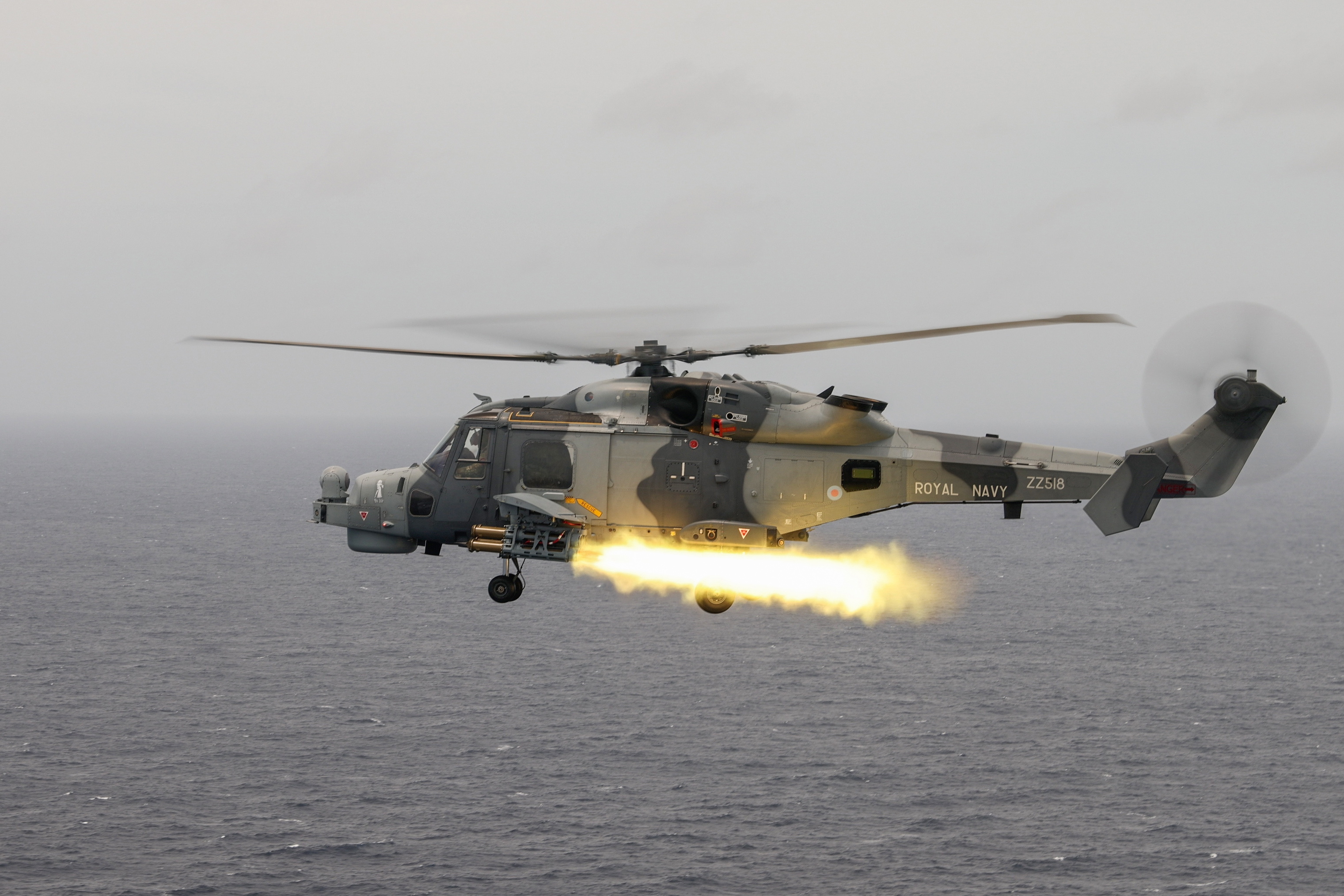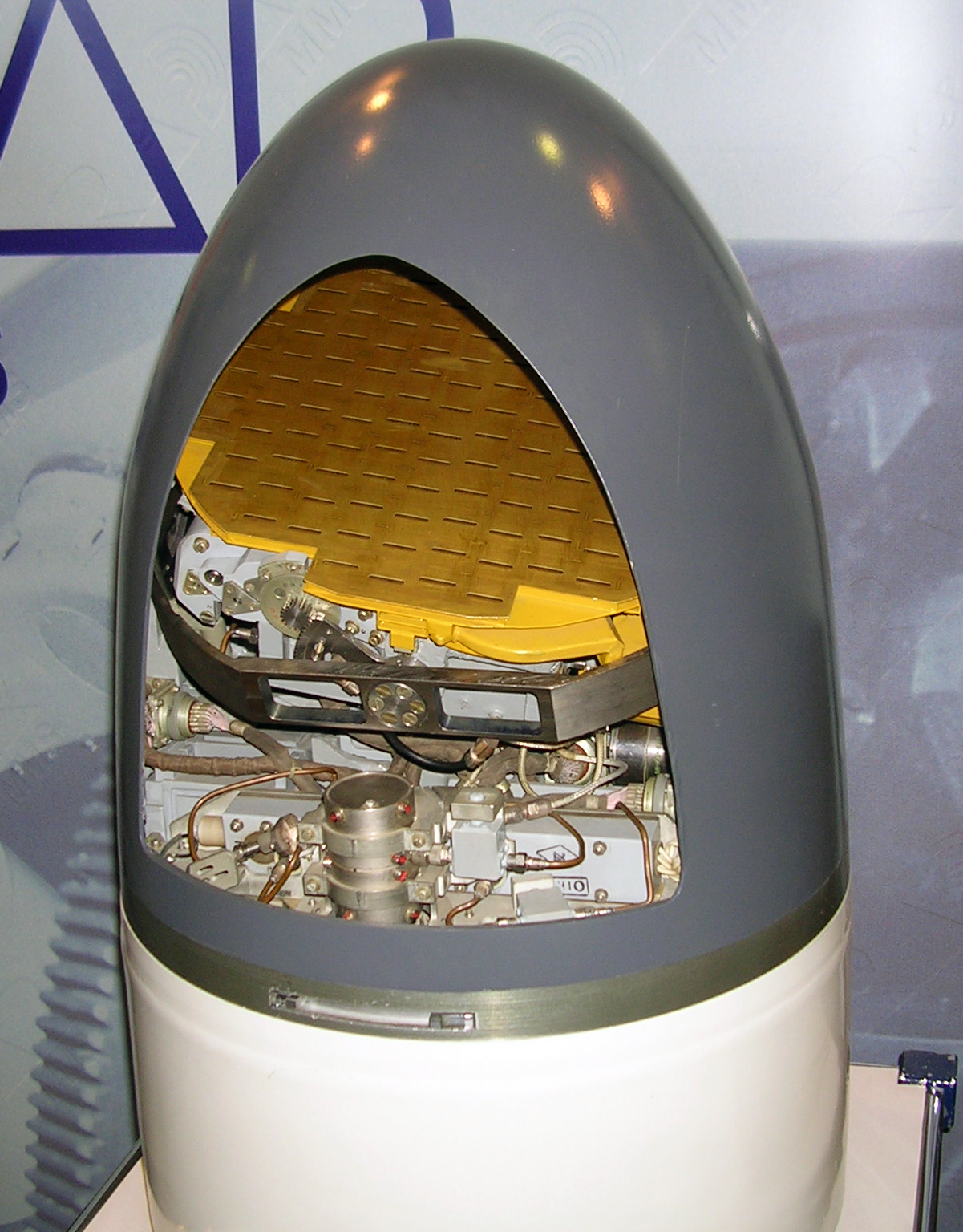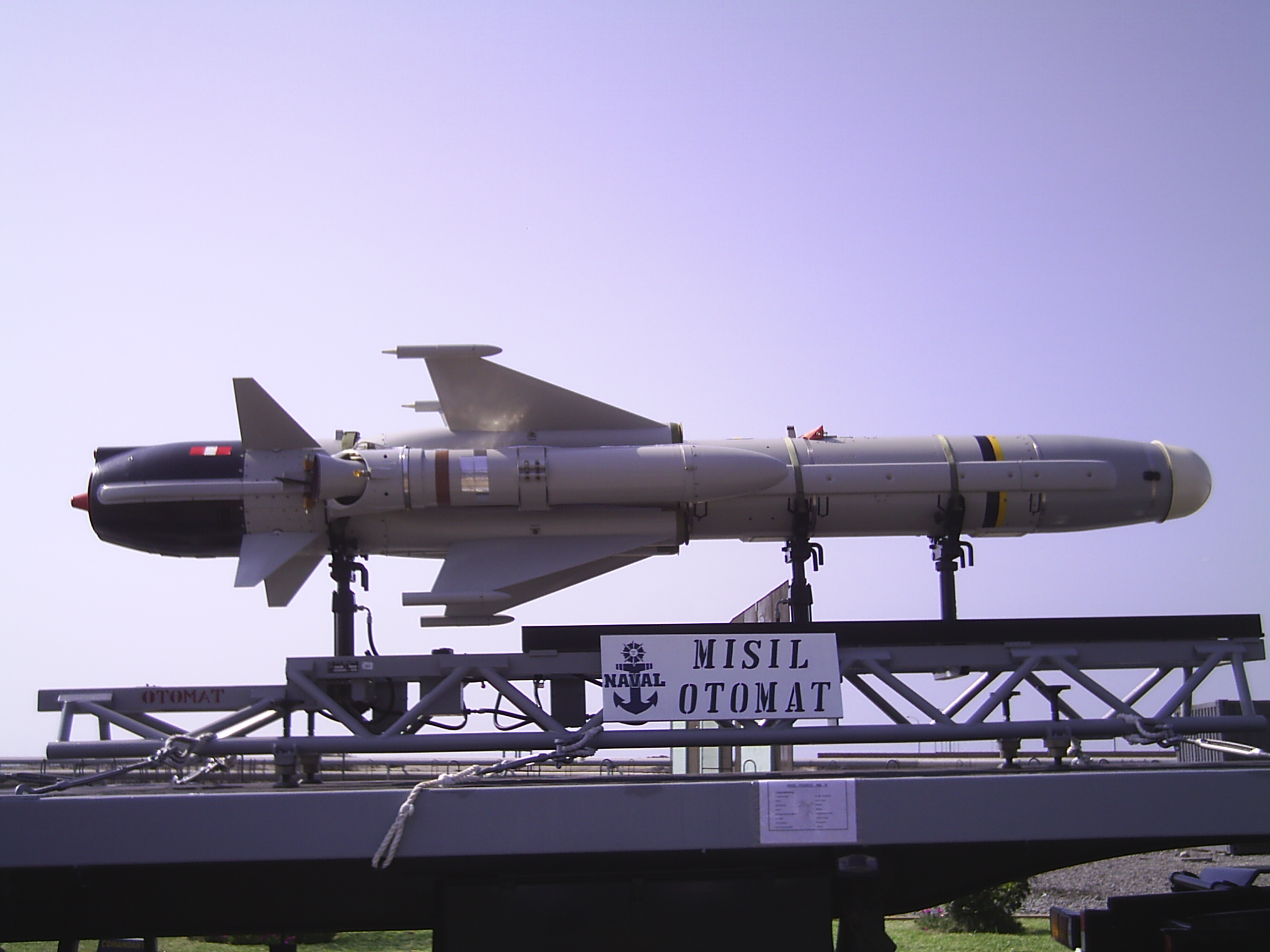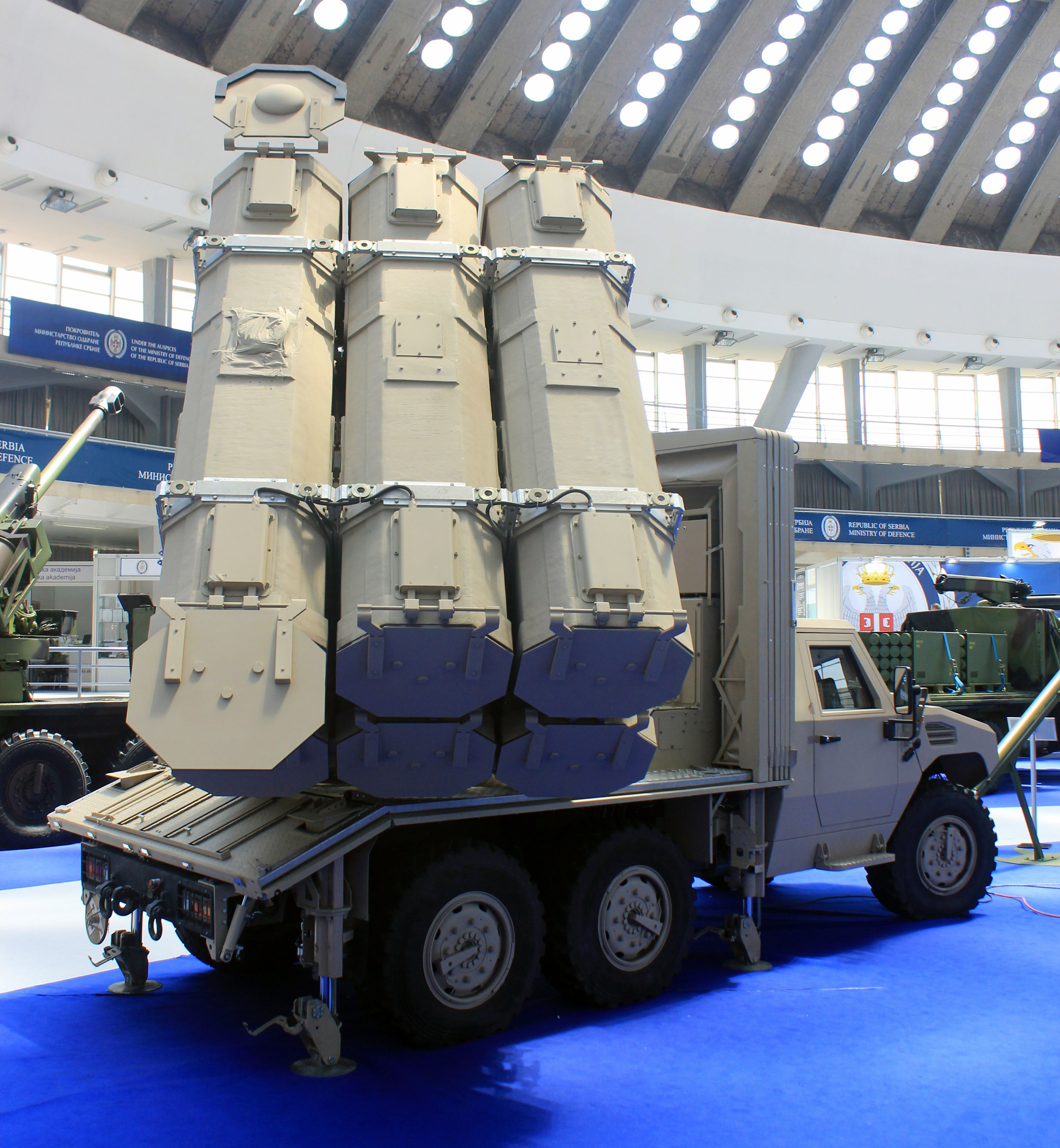|
Surface-to-surface
A surface-to-surface missile (SSM) or ground-to-ground missile (GGM) is a missile designed to be launched from the ground or the sea and strike targets on land or at sea. They may be fired from hand-held or vehicle mounted devices, from fixed installations, or from a ship. They are often powered by a rocket engine or sometimes fired by an explosive charge, since the launching platform is typically stationary or moving slowly. They usually have fins and/or wings for lift and stability, although hyper-velocity or short-ranged missiles may use body lift or fly a ballistic trajectory. The V-1 flying bomb was the first operational surface-to-surface missile. Contemporary surface-to-surface missiles are usually guided. An unguided surface-to-surface missile is usually referred to as a rocket (for example, an RPG-7 or M72 LAW is an anti-tank rocket whereas a BGM-71 TOW or AT-2 Swatter is an anti-tank guided missile). Examples of surface-to-surface missile include the MGM-140 ATACMS, t ... [...More Info...] [...Related Items...] OR: [Wikipedia] [Google] [Baidu] |
Hermes (missile)
Hermes (russian: Гермес) is a family of modularly designed guided missiles developed in Russia by the KBP Instrument Design Bureau. The Hermes missile can be used from air, ground or naval launchers. Development Development of the Hermes by the KBP Instrument Design Bureau started in the 1990s. The missile bears a striking resemblance to the Pantsir missile system#Missiles, 57E6 used by the Pantsir missile system, and it is probably a derivative of this model. The Hermes-A variant was trialed in 2003. The series production of the Hermes was meant to start in 2011-2012, but this did not happen, as the development process was stopped for several years. In 2016, it was announced that the Hermes missile would be tested in live conditions in Syria. However, nothing indicates that this actually happened. But in the late 2010s, a series of announcements signaled a renewed interest in the missile, following experience from the Russian military intervention in the Syrian civil war ... [...More Info...] [...Related Items...] OR: [Wikipedia] [Google] [Baidu] |
Lightweight Multirole Missile
Martlet is a lightweight air-to-surface, surface-to-air, and surface-to-surface missile developed by Thales Air Defence for the United Kingdom. It is named after a mythical bird from English heraldry that never roosts, the martlet. Developed as the Lightweight Multirole Missile (LMM) to meet the UK's "Future Air-to-Surface Guided Weapon (Light)" requirement, the Ministry of Defence (MOD) placed an initial order for 1,000 missiles with deliveries due to start in 2013. However, initial operating capability was considerably delayed and took place in 2021 with full operating capability anticipated in 2024. The missile was given the name "Martlet" in British service. Development The Lightweight Multirole Missile was initially conceived as Thales' response to the MoD's Future Air-to-Surface Guided Weapon (Light) FASGW(L) requirement. It was designed to be launched from a variety of naval, air and land platforms against a wide range of targets. High precision reduces collateral damage ... [...More Info...] [...Related Items...] OR: [Wikipedia] [Google] [Baidu] |
3M-54 Kalibr
The 3M-54 Kalibr, (Калибр, caliber), also referred to it as 3M54-1 Kalibr, 3M14 Biryuza (Бирюза, turquoise), (NATO reporting name SS-N-27 Sizzler and SS-N-30A) is a family of Russian cruise missiles developed by the Novator Design Bureau (OKB-8). There are ship-launched, submarine-launched and air-launched versions of the missile, and variants for anti-ship, anti-submarine and land attack use. Some versions have a second propulsion stage that initiates a supersonic sprint in the terminal approach to the target, reducing the time that target's defense systems have to react, while subsonic versions have greater range than the supersonic variants. The missile can carry a warhead weighing up to of explosive or a thermonuclear warhead. Design The missile is a modular system with five versions: two anti-shipping types, one for land attack and two anti-submarine types. The missile is designed to share common parts between the surface and submarine-launched variants but ea ... [...More Info...] [...Related Items...] OR: [Wikipedia] [Google] [Baidu] |
Long Range Precision Fires
The Field Artillery Branch is a combat arms branch of the United States Army that is responsible for field artillery. Historical background The U.S. Army Field Artillery branch traces its origins to 17 November 1775 when the Continental Congress, unanimously elected Henry Knox "Colonel of the Regiment of Artillery". The regiment formally entered service on 1 January 1776. During the 19th Century a total of seven Artillery regiments were formed which contained a mixture of "heavy" artillery companies and "light" artillery batteries. The light artillery batteries took the role of field artillery although they did not use that designation. The seven artillery regiments were designated as regiments of artillery and were not distinguished as being either "coast" or "field" artillery as was the practice in the 20th Century. In the reorganization of the Army by the Act of 2 February 1901, the seven Artillery regiments were reorganized as the Artillery Corps. The Corps was split into ... [...More Info...] [...Related Items...] OR: [Wikipedia] [Google] [Baidu] |
P-800 Oniks
The P-800 Oniks (russian: П-800 Оникс; en, Onyx), also known in export markets as Yakhont (russian: Яхонт; en, ruby), is a Soviet / Russian supersonic anti-ship cruise missile developed by NPO Mashinostroyeniya as a ramjet version of P-80 Zubr. Its GRAU designation is 3M55, the air launched Kh-61 variant also exists. The missile has the NATO codename SS-N-26 " Strobile". Development officially started in 1983, and in the 1990s the anti-ship missile was tested on the Project 1234.7 ship. In 2002 the missile passed the whole range of trials and was commissioned. It is reportedly a replacement for the P-270 Moskit, and possibly also of the P-700 Granit. Description The missile is carried in flight by aerodynamic lift. The solid-propellant booster is located in the ramjet's combustion chamber and is ejected by the airflow after it has burned out. Advantages *Over-the-horizon firing range *Full autonomy of combat use ("fire and forget") *A set of flexible ("low-profi ... [...More Info...] [...Related Items...] OR: [Wikipedia] [Google] [Baidu] |
Atmaca
ATMACA (''Accipiter'') is an all weather, long range, precision strike, anti-ship cruise missile, developed by Turkish missile manufacturer ROKETSAN. The ''Atmaca'' will enter service with the Turkish Navy to gradually replace the country's existing inventory of Harpoon missiles. Development The program was initiated in 2009 when Turkey's Undersecretary For Defense Industries (SSM) signed a contract with Roketsan for designing a surface-to-surface cruise missile for the requirements of the Turkish Naval Forces. The prime contractor, Roketsan, started the design studies in September 2012, after receiving the results of its previous research and development contract with Turkey's Undersecretary For Defense Industries under the coordination of Navy Research Center Command (ARMERKOM). The missile is planned to be developed for multiplatforms, capable of launching not only from warships but also from submarines, aircraft, coastal batteries, including land-attack operations. After ... [...More Info...] [...Related Items...] OR: [Wikipedia] [Google] [Baidu] |
Kh-35
The Zvezda Kh-35 (russian: Х-35 , AS-20 'Kayak') is a Soviet turbojet subsonic cruise anti-ship missile. The missile can be launched from helicopters, surface ships and coastal defence batteries with the help of a rocket booster, in which case it is known as ''Uran'' ('Uranus', SS-N-25 'Switchblade', GRAU 3M24) or ''Bal'' (SSC-6 'Sennight', GRAU 3K60). It is designed to attack vessels up to 5,000 tonnes. Development The previous anti-ship missiles made in USSR were highly capable, but they also were large and expensive. Therefore, the Soviet Navy found that a similar, small and very low flying missile would be useful. This new system was planned as small, cheap, and easy to install missile for a variety of platforms. This new system, called 3M24 Uran (in western nomenclature, SS-N-25) was originally meant for small surface combatants such as frigates, like the Krivak, Gepard and Neustrashimy. It was the answer to western missiles like the US Harpoon. Informally, it was also ... [...More Info...] [...Related Items...] OR: [Wikipedia] [Google] [Baidu] |
RBS-15
The RBS 15 (Robotsystem 15) is a long-range fire-and-forget surface-to-surface and air-to-surface anti-ship missile. The later version Mk. III has the ability to attack land targets as well. The missile was developed by the Swedish company Saab Bofors Dynamics. History The Swedish Navy earlier made the RB 08 anti-ship missiles with the Halland-class destroyers in the early 1960s. The main effect of Sweden's defence resolution of 1958 for the Swedish navy was restructuring into a lighter force consisting of fast attack craft (FAC) vessels and a halt to destroyer procurement. This posed a problem as the existing RB 08 missile required launch rails and a missile magazine in the destroyers, taking up space that was not available in smaller ships. Adding to the problems, each missile had to be individually prepared for launch and only two missiles could be on the launch rails at the same time. In comparison, the P-15 Termit (NATO codename Styx) missile used by the Soviet Union fr ... [...More Info...] [...Related Items...] OR: [Wikipedia] [Google] [Baidu] |
Bina (missile)
Bina ( fa, بینا)Literally meaning "insightful" is an Iranian laser guided dual-capability surface-to-surface and air-to-surface missile. History It was successfully tested by Iranian military on February 10, 2014, according to Janes and Reuters. It appears to be an AGM-65 Maverick air-to-ground missile with a semi-active laser (SAL) seeker fitted to its nose. Brigadier General Hossein Dehqan said the ballistic missile had radar-evading capabilities. "The new generation of long-range ground-to-ground ballistic missile with a fragmentation warhead Fragmentation is the process by which the casing, shot, or other components of an anti-personnel weapon, bomb, barrel bomb, land mine, IED, artillery, mortar, tank gun, or autocannon shell, rocket, missile, grenade, etc. are dispersed and/ ... and the laser-guided air-to-surface and surface-to-surface missile dubbed Bina (Insightful) have been successfully test-fired. The Bina missile is capable of striking important targets s ... [...More Info...] [...Related Items...] OR: [Wikipedia] [Google] [Baidu] |
Otomat
The Otomat is an anti-ship and coastal defence missile developed by the Italian company Oto Melara jointly with Matra and now made by MBDA. The name comes, for the first versions, from the name of the two builders ("Oto Melara" and "Matra") and, for the later versions, Teseo, from the Italian word for Theseus. The MILAS variant is an anti-submarine missile. In its latest version Mk/2E purchased by the Italian Navy is a medium range anti-ship missile and a ground attack missile. Origins The Otomat missile program started in 1967, the same year in which the Israeli destroyer ''Eilat'' was sunk by three Soviet-made P-15 Termit anti-ship missiles. This event raised awareness about the effectiveness of such weapons and prompted the development of similar systems in Western countries, such as the Harpoon in the United States. However, it is unknown whether the Otomat program started before or after the Eilat event. The Otomat program was undertaken by the Italian Oto Melara corporat ... [...More Info...] [...Related Items...] OR: [Wikipedia] [Google] [Baidu] |
ALAS (missile)
ALAS (Advanced Light Attack System, sr, АЛАС) is a Serbian long-range multipurpose wire guided missile system developed by the private company EdePro and the state-owned Yugoimport SDPR. The ALAS missile system was developed primarily for missions against tanks, armored vehicles, fortifications, command posts, low-flying helicopters, coastal ships, industrial facilities and bridges. It can be deployed by any suitable platform including helicopters, armored vehicles, small ships and infantry. The guidance system is based on video/infrared technology, with the missile connected to the launcher by a fiber-optic cable. The ALAS flies at low altitude and has small radar and infrared (heat) signatures due to using a turbofan motor instead of a turbojet. In recent years, the ALAS platform has found a secondary use as a UAV. Description of system and role The ALAS missile system is intended for two primary missions: * Striking isolated targets from light land vehicles and for an ... [...More Info...] [...Related Items...] OR: [Wikipedia] [Google] [Baidu] |
Polyphem
The Polyphem was a proposed light-weight fibre-optic wire-guided surface-to-surface missile with a range of 60 km. It uses a sealed round, a solid propellant booster rocket to launch the missile out of its canister to an initial height, so that the wings and control surfaces can unfold, and a more fuel economic turbojet cruise engine kicks in to propel the missile. The missile can be programmed to follow a preset course, using Global Positioning System, GPS or inertial guidance. An infrared seeker can be used to automatically pick a target and for the terminal guidance phase, but it is also possible to transfer the thermal images back to the launching platform via a 200 Bit rate, MBit/s data link provided by an optical fibre, and manually select the target. The Polyphem program was started in 1994 by Germany, France and Italy. Italy later left the project. A naval version, called Polyphem-S, was initially selected for the Braunschweig class corvette as anti-ship missile, anti- ... [...More Info...] [...Related Items...] OR: [Wikipedia] [Google] [Baidu] |







